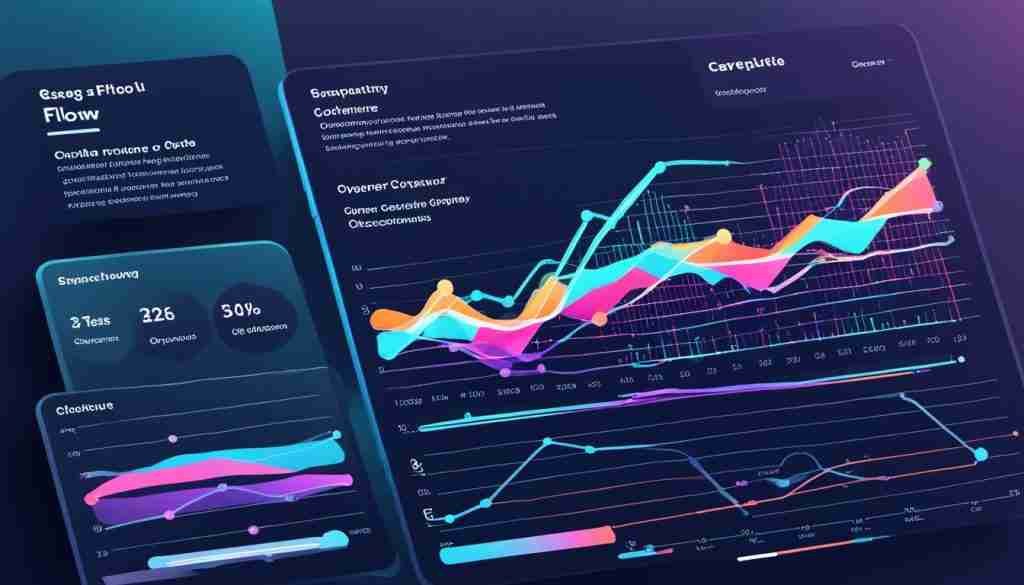
Did you know that in 2020, mobile devices accounted for over 50% of global internet traffic? That’s right, more than half of all internet users were accessing the web from their smartphones and tablets. With the increasing popularity and importance of mobile usage, it’s crucial for businesses to ensure that their mobile apps are optimized for a seamless user experience.
Mobile optimization metrics provide valuable insights into various aspects of a mobile app’s performance, including user acquisition, engagement, app store ratings, crashes and errors, in-app purchases, and user demographics. By closely monitoring these metrics, organizations can make data-driven decisions to improve the user experience and drive growth.
Key Takeaways:
- Mobile devices account for over 50% of global internet traffic.
- Mobile optimization metrics provide insights into user acquisition, engagement, app store ratings, crashes and errors, in-app purchases, and user demographics.
- Monitoring these metrics allows organizations to make data-driven decisions to improve the user experience and drive growth.
Key Performance Indicators (KPIs) for Mobile App Performance
In order to accurately assess the performance of your mobile app, it’s essential to go beyond just technical measurements. Tracking key performance indicators (KPIs) allows you to gain valuable insights into various aspects of your app’s performance, enabling data-driven decisions to enhance user experience and boost conversions. Here are the crucial KPIs to monitor:
User Acquisition
User acquisition focuses on measuring the number of new users who download and install your app. This metric helps you understand the effectiveness of your marketing campaigns and the overall growth of your user base.
User Engagement
User engagement refers to the level of interaction and value that users find in your app. By measuring user engagement metrics such as session duration, screens per session, and user retention rate, you can gauge how well your app is capturing and maintaining users’ interest.
App Store Ratings and Reviews
App store ratings and reviews provide valuable feedback on the quality and usability of your app. Positive ratings and reviews can significantly impact your app’s visibility and attract new users, while negative feedback helps identify areas for improvement.
App Crashes and Errors
Tracking app crashes and errors is crucial for identifying issues that impact the user experience. By monitoring crash rates and error logs, you can pinpoint problem areas within your app and prioritize bug fixes to ensure a smoother user journey.
In-App Purchases
In-app purchases measure the effectiveness of your business strategy and the extent to which users are converting into paying customers. Tracking this metric helps optimize your monetization efforts and drive revenue growth.
User Demographics
Understanding the demographics of your user base allows you to tailor your app to better meet their specific needs and preferences. By monitoring user demographics, such as age, gender, location, and interests, you can optimize your app’s design, content, and features for maximum engagement.
By closely monitoring these mobile app performance metrics, you can gain valuable insights into your app’s performance and make data-driven decisions to optimize user experience and drive business growth.

Importance of Observability for Mobile App Performance Monitoring
Observability data plays a crucial role in monitoring the performance of mobile apps. By providing developers with deeper insights into their applications through metrics, logs, and traces, observability data offers visibility into the behavior and performance of mobile apps at different levels of the stack.
One key area where observability data proves essential is issue remediation. It helps developers identify and diagnose performance issues, enabling them to implement targeted fixes and improve the overall app experience.
Furthermore, observability data allows for proactive monitoring, empowering developers to identify potential issues before they become critical. By actively monitoring app performance and detecting anomalies, developers can take proactive measures to prevent user dissatisfaction and negative impacts on their business.
Another significant benefit of observability data is its role in performance optimization. By leveraging observability data, developers can pinpoint areas within their apps that may be slow or resource-intensive. With this valuable information, developers can optimize app responsiveness and resource consumption to deliver smooth performance and enhance user experience.
Observability data also aids in capacity planning. By analyzing trends in resource consumption, developers can effectively plan for future usage and ensure optimal scalability. This enables them to allocate resources efficiently, providing a seamless experience to users even during peak usage periods.
Crash and error reporting becomes more focused with the help of observability data. Developers can prioritize issues based on their impact on user experience, addressing critical errors promptly and ensuring a smooth app environment.
Finally, observability data provides insights into load time and network latency metrics. This information is crucial in isolating the causes of performance issues and addressing them effectively. By optimizing load time and reducing network latency, developers can significantly improve app speed and responsiveness, resulting in a better user experience.

Conclusion
Monitoring mobile app performance is crucial for businesses to thrive in the competitive mobile landscape. By tracking essential mobile optimization metrics, you can enhance the user experience, improve app performance, and drive conversions. Leveraging mobile app analytics provides valuable insights into user engagement, retention rate, conversion rate, and revenue.
With the help of Ma Consulting Services and their website MaConsultingServices.site, you can effectively track and analyze key performance indicators. These metrics allow you to make data-driven decisions and optimize your mobile app for success.
By continuously monitoring and fine-tuning your app based on mobile app performance metrics, you can ensure that your users are engaged, satisfied, and loyal. This will not only boost retention rates but also increase conversion rates and generate more revenue for your business.



